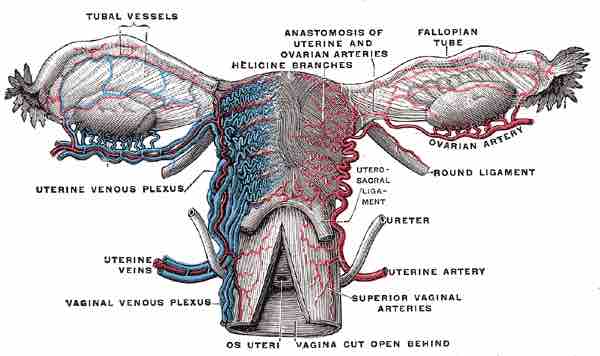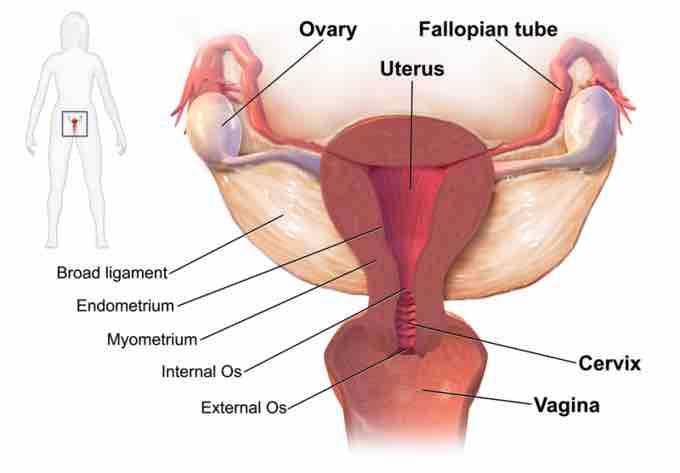The uterus or womb is a major female hormone-responsive reproductive sex organ of most mammals including humans. One end, the cervix, opens into the vagina, while the other is connected to one or both fallopian tubes, depending on the species. It is within the uterus that the fetus develops during gestation, usually developing completely in placental mammals such as humans.
Two Müllerian ducts usually form initially in a female fetus and, in humans, they completely fuse into a single uterus depending on the species. The uterus consists of a body and a cervix. The cervix protrudes into the vagina. The uterus is held in position within the pelvis by condensations of endopelvic fascia, which are called ligaments. These ligaments include the pubocervical, transverse, cervical, cardinal, and uterosacral ligaments. It is covered by a sheet-like fold of peritoneum, the broad ligament.
The uterus is essential in sexual response by directing blood flow to the pelvis and to the external genitalia, including the ovaries, vagina, labia, and clitoris. The reproductive function of the uterus is to accept a fertilized ovum which passes through the utero-tubal junction from the fallopian tube. It implants into the endometrium, and derives nourishment from blood vessels which develop exclusively for this purpose.

Uterus
Vessels of the uterus and its appendages, rear view.
The fertilized ovum becomes an embryo, attaches to a wall of the uterus, creates a placenta, and develops into a fetus (gestates) until childbirth. Due to anatomical barriers such as the pelvis, the uterus is pushed partially into the abdomen due to its expansion during pregnancy. Even during pregnancy, the mass of a human uterus amounts to only about a kilogram (2.2 pounds).
The uterus is located inside the pelvis immediately dorsal (and usually somewhat rostral) to the urinary bladder and ventral to the rectum. The human uterus is pear-shaped and about three inches (7.6 cm) long. The uterus can be divided anatomically into four segments: The fundus, corpus, cervix and the internal os.

ovary.png
A pictorial illustration of the female reproductive system.
The uterus is in the middle of the pelvic cavity in frontal plane (due to ligamentum latum uteri). The fundus does not surpass the linea terminalis. The fundus of the uterus is the top, rounded portion, opposite from the cervix. The vaginal part of the cervix does not extend below interspinal line. The uterus is mobile and moves under the pressure of the full bladder or full rectum anteriorly, whereas if both are full it moves upwards. Increased intra-abdominal pressure pushes it downwards. The mobility is conferred to it by musculo-fibrous apparatus that consists of a suspensory and sustentacular part. Under normal circumstances the suspensory part keeps the uterus in anteflexion and anteversion (in 90% of women) and keeps it "floating" in the pelvis. In cases where the uterus is "tipped," also known as retroverted uterus, women may have symptoms of pain during sexual intercourse, pelvic pain during menstruation, minor incontinence, urinary tract infections, difficulty conceiving, and difficulty using tampons. A pelvic examination by a doctor can determine if a uterus is tipped.
The lining of the uterine cavity is called the endometrium. It consists of the functional endometrium and the basal endometrium from which the former arises. Damage to the basal endometrium results in adhesion formation and/or fibrosis (Asherman's syndrome). In all placental mammals, including humans, the endometrium builds a lining periodically which is shed or reabsorbed if no pregnancy occurs. Shedding of the functional endometrial lining is responsible for menstrual bleeding (known colloquially as a "period" in humans, with a cycle of approximately 28 days, +/- 7 days of flow and +/- 21 days of progression) throughout the fertile years of a female and for some time beyond.
Depending on the species and attributes of physical and psychological health, weight, environmental factors of circadian rhythm, photoperiodism (the physiological reaction of organisms to the length of day or night), the effect of menstrual cycles to the reproductive function of the uterus is subject to hormone production, cell regeneration, and other biological activities. The menstrual cycles may vary from a few days to six months, but can vary widely even in the same individual, often stopping for several cycles before resuming.
The uterus mostly consists of smooth muscle, known as myometrium. The innermost layer of myometrium is known as the junctional zone, which becomes thickened in adenomyosis. The parametrium is the loose connective tissue around the uterus. The perimetrium is the peritoneum covering of the fundus and ventral and dorsal aspects of the uterus. The uterus is primarily supported by the pelvic diaphragm, perineal body, and the urogenital diaphragm. Secondarily, it is supported by ligaments and the peritoneum (broad ligament of uterus).